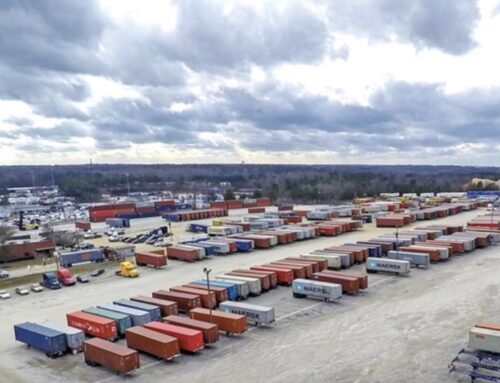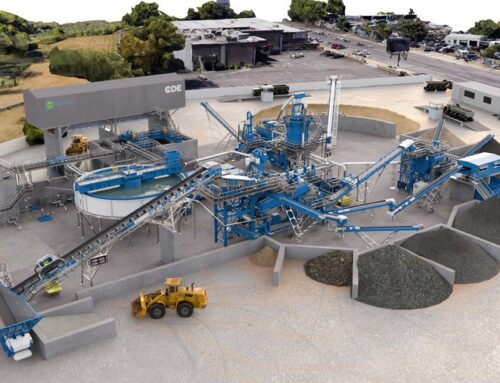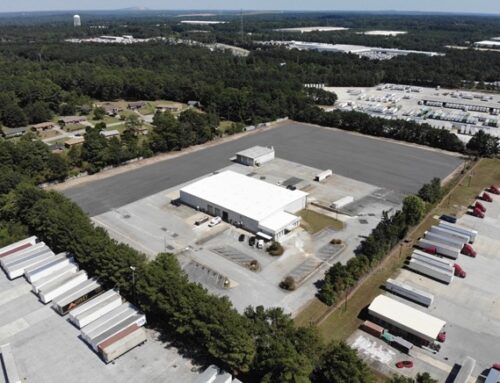IOS, as some in the sector call it, refers to properties that mostly provide uncovered ground to keep items often needed by industrial users with other business nearby, from truck trailers to construction materials. Over the course of the past couple of years, national players like Brookfield Properties and JPMorgan Asset Management have come around to IOS as an asset class that costs very little to maintain but has a reliable cash flow and a favorable ratio of supply to demand.
The most common IOS sites range from 3 to 20 acres, with less than 25% of land occupied by buildings (a small office for site management, in most cases). The property type is far from new, but has been the exclusive province of either owner-occupiers or local and regional property owners until very recently, multiple sources told Bisnow.
Unlike distribution centers, which have strong demand but also steadily expanding supply, there is little reason to believe that the pool of available properties will grow significantly anytime soon. Any property that would be well-located for IOS is also suited for higher, better uses of land, from warehouses up to multifamily developments. Even those who extol the virtues of IOS as an investment recognize how low it ranks on the scale of acceptable uses of real estate for municipalities.
“The entitlements just aren’t there,” said Devin Barnwell, Brookfield Properties’ U.S. head of real estate management and logistics. “I haven’t seen truck terminals being developed anywhere in the country.”
For many users, IOS is mission-critical real estate, meaning it is an irreplaceable part of a company’s business model, multiple sources told Bisnow. Logistics companies, including shipping giants FedEx and UPS, use outdoor truck terminals to quickly move goods from one truck to another without clogging up the traffic at a distribution center. Construction companies that use IOS to store building materials have few, if any, alternatives for where to keep them near a construction site but not on it.
Because IOS sites are only useful insofar as they service a core business located somewhere else, they are generally only viable within metropolitan areas and very close to roadways that can handle truck volume. For truck terminals or storage of shipping containers, proximity to a port is also important.
“In the supply chain, transportation is about 50% of costs, and when you think about the last mile being the most expensive, the critical nature of these properties really is location,” Barnwell said.
The most common lease structure at industrial outdoor storage properties is a “true triple-net” lease, wherein the tenant is responsible for nearly all site upkeep and costs, Barnwell said. The biggest capital expenditure a landlord might be responsible for is pavement replacement in lots where the weight of what is stored exceeds a surface’s capacity.
Add up the above factors, and IOS reads like an investor’s dream: simple to manage, easy to lease, reliable as a source of revenue and with higher average cap rates than distribution centers. No wonder that the pool of buyers has rapidly become more crowded.
Brookfield has only been active in IOS — specifically truck terminals — since mid-2019, but the product already accounts for 10% of its logistics portfolio in terms of dollar value. The private equity giant wants to own from $300M to $500M worth of IOS property, a number it is “quite a ways away from at this point,” Barnwell said.
Alterra Property Group, known in its hometown of Philadelphia as a developer of mixed-use and multifamily projects, began investing in industrial outdoor storage sites in 2017, not long after a Chicago-based company named Industrial Outdoor Ventures was formed specifically to acquire and manage such properties.
At that time, IOS resembled single-family rental properties and self-storage in terms of its ownership and treatment by the national investment market, Alterra partner Matt Pfeiffer said. When Alterra entered the sector, it estimated that about $15B of IOS deals had transacted in the previous year or so, with an average deal size of $5M.
There is already more demand for IOS than there is supply, and the disparity looks like it can only grow. While that creates an appealingly high barrier to entry for investors, it means that the only way an investor can build scale is through acquisitions. Institutional investors have little time to source such small deals with local owners and, potentially, local brokers.
“We saw an opportunity to institutionalize the asset class, and to bring in programmatic debt and capital at a national scale,” Pfeiffer said.
Alterra now has an ownership stake in more than 40 properties across 12 states, with a handful of them acquired as part of a $300M joint venture it formed with JPMorgan Chase in December. JPMorgan had already been involved in the asset class for “many years,” JPMorgan Asset Management Acquisitions Vice President Dan Schuchinsky told Bisnow in an email, but entered the JV with Alterra as part of a new commitment to growing scale in IOS. In June, Alterra announced that the JV had obtained a $100M credit facility from Morgan Stanley.
Though deal sourcing has been the primary challenge for investors looking to scale up in IOS, more portfolio deals are becoming available this year, Pfeiffer and Barnwell agreed. Brookfield purchased a $27M IOS portfolio in May.
“We’ve been talking about small deal aggregation, but there are middle-market private equity funds and users that see the value in doing a sale-leaseback with outdoor storage space,” Pfeiffer said. “So there are portfolio deals out there.”
Once owners reach a certain scale, they can begin to leverage that scale to make portfolio-sized lease deals with regional and national tenants. Both Alterra and Brookfield have sourced IOS properties for tenants at distribution centers they also own, and Alterra recently executed a sale-leaseback deal with one occupier that had a portfolio of 20 properties.
“Amazon, FedEx, UPS — those are all tenants of ours in warehouses in addition to truck terminals,” Barnwell said. “And there are a lot of third-party logistics that use them as well, so we see a large demand from our tenants.”
A market with fundamentals as strong as IOS can expect to see prices rise as it becomes more competitive, but Barnwell said that so far, values haven’t shifted much since Brookfield entered the market over a year ago. Considering the state of the economy, that is a minor miracle that may not hold true for long.
Much like with distribution centers, outdoor storage has not suffered any significant headwinds as a result of the coronavirus pandemic. The increased demand for e-commerce benefits IOS as a link in the supply chain, and outdoor sites are inherently less dangerous in terms of contagion.
“When we got into this business, the one thing we couldn’t answer for capital partners is how this would perform in a downturn,” Pfeiffer said. “But we’ve had 100% on-time rental payments, so that has performed well. We’re selling a few pre-COVID assets in the venture already to harvest the portfolio at good multiples, and we’ve done leasing transactions at substantially higher rates than in-place rents.
“So the data is proving to be strong that this is resilient in a downturn.”
Source Article by Bisnow





